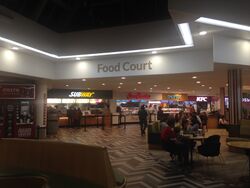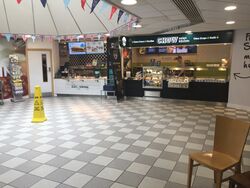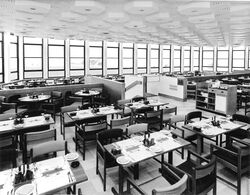Catering at motorway services

The catering at motorway service stations has a long and unpleasant history, which is covered under How To Design A Service Station. This page provides a little more detail on a few key points.
Most service station operators see themselves as operators of popular coffee and fast food brands, a category known as QSR. These are usually operated under a franchise agreement, where the service station provides the staff and gets to set its own prices.
There are some notable exceptions to this: Extra do not run any of the food brands which are provided at their services. Sometimes they are ran by the brand directly, but often they are ran by another operator. On the other hand Westmorland do run their own food brands, but they do not use any existing chains, and instead focus on their own menu of locally-sourced products.
A list of all the catering names available at each service station, and the ability to search for one, is provided in our database. Complaints about food at a service station should normally be directed to the operator, or to the name on the receipt.
More Than Just Burgers

See also: Quick service restaurant
While the majority of service station customers are interested in the famous fast food names, the larger services have been trying to introduce a little variety. Chozen Noodle and El Mexicana are examples of this, while Tossed was the first brand to make motorway food healthy. Asian fast food restaurant Chow is especially interesting because it was specially created by Moto to fill a gap in the fast food market.
Having completely moved away from long-form dining, Welcome Break have now brought it back to their busiest services with established restaurant chain PizzaExpress. The theory is that while most people want to eat as quickly as possible, some families are willing to hang around. Moto also trialled an established restaurant, Harvester.
The quandary for service station operators is that while most customers now want as quick a meal as possible, in the mornings breakfast is still popular. Partnering with the likes of Harry Ramsden's and Harvester means this can be accommodated within the existing menu. At the other services, the remains of the self-branded restaurant have been used to provide this, usually with smaller counters and vastly reduced opening hours. Some now alternate between being a breakfast bar in the morning and an unrelated brand name in the afternoon.
Food Quality

The consequence of food being served under established brand names is that there is usually a minimum quality that can be expected. If the food is not up to scratch, customers will start complaining to the brand who's name is being sullied.
The very first motorway services were famed for their fine dining. This trend was at least partly a trick: service stations paid rent to the government based on turnover, so a more luxurious service station would have higher prices, offer the government more revenue, and therefore be more likely to win the contract. The phase was short-lived, and low revenue soon caused quality to be compromised. Meanwhile, lorry drivers were happy to be served 'cheap and cheerful' greasy-spoon style food in the transport café.
Over time the two classes of customer were merged, and long buffet counters would charge high prices for low quality food. Despite a number of efforts to refurbish and revitalise the restaurants, including efforts to automate them, the overall impression was that most places either didn't care or were being forced to stick to a business plan that they knew wasn't working.
Deregulation in the 1980s was supposed to encourage new ideas, and these mainly took the form of fast food concessions. This truly took hold in the late 1990s, with many established brand names being placed together in large food courts, while the remaining waitress-service restaurants were removed.
With fast food and coffee succeeding in getting people in the door, one last-ditch effort was made to cater for the sit-down market, with large restaurants changing to tiny counters that had an emphasis on the freshness and quality of their food. In particular, Welcome Break invested heavily in Eat In, but slowly it was pushed out the picture as more and more customers favoured the fast food alternatives.
Highway authorities have ruled out taking action against service areas with poor quality or an uninspiring choice of food, although local authorities can still take action against health hazards.
Comparisons with Europe
Since the 1960s, comments have been made about European services being much better. Several official studies have taken place, and they have always concluded that when you compare like-with-like, there isn't much difference.
The early British motorway services were inspired by America, West Germany and Italy. They quickly discovered that most British customers didn't want the elaborate sit-down meals that Italy had made famous. In addition, British service areas tend to have small buildings (hampered by expensive land prices) and intense traffic flows, which makes fast food catering more practical.
While there is no doubt that there is demand for a decent meal on the motorway, as isolated examples like Gloucester and Tebay have proven, if the demand for a restaurant like theirs were to be spread out across 100 service areas the business model would become a lot less sustainable. The bottom line is experience has taught service stations that the majority of visitors would rather have a quick snack or a meal from a famous brand than anything more fancy.
A survey in 2006 established that approximately 45% of visitors were using the food facilities at a service station, which is higher than you might expect.
Requirements
Under the MSA Policy, hot drinks and hot food must be made available throughout the service station's opening hours; 24 hours in the case of motorway services. However, there is nothing forbidding those food and drinks being served by automated vending machines.